Romancing the Dijon Clones
All Pinot Noir clones planted in North American originally came from France. In the early 1970s, three Pinot
Noir clones were available from University of California at Davis: Pommard (UCD 4), Wädenswil and a third minor clone mislabeled as Gamay
Beaujolais. According to Jason Lett of The Eyrie Vineyards, the Wädenswil clone was a selection done by the Swiss Federal Research Station in Wädenswil, Switzerland in the 1950s from ancient clones brought to the Zurich area by Swiss mercenaries who fought for the King of France in the Burgundian Wars of the 1470s. The Wädenswil clone was selected for its excellent ripening in a cool climate and natural disease resistance, qualities that contributed to its success in Oregon. David Lett brought a carload of Wädenswil 1A clone cuttings from the University of California at
Davis (who imported it from Switzerland) to Oregon in 1965. Pommard clone UCD 5 was introduced to Oregon by Dick Erath and Charles Coury as part of their joint nursery venture in the early 1970s.
The Pommard clone was originally sourced from the Château de Pommard in Burgundy by Dr. Harold Olmo at
University of California at Davis’ Department of Viticulture and Enology. Dick Erath and Charles Coury brought the Pommard clone to Oregon in the early 1970s. Subsequently, Coury sold some vines from his nursery that he had brought to the United States from Alsace as Pommard, and they became known in Oregon as the "Coury clone." After these vines were planted, it became clear within a few years that the "Coury clone" was not Pommard.
Oregon Pinot Noirs of the 1970s were often a blend of Pommard UCD 5, Wädenswil and the Coury
clone. The workhorse Pinot Noir clones in California then were Pommard, and what are now termed “heritage
clones,” most of which were originally suitcase clones smuggled into the United States from France. The
eventual importation of Dijon clones of Pinot Noir to Oregon was to dramatically changed the course of Pinot
Noir winegrowing in the United States.
Winemaker and winery proprietor John M. Kelly (Westwood Winery, Sonoma, www.winemakernotesblog.com),
related to me some of the historical events that transpired leading to the discovery of the Dijon clones of Pinot
Noir. Kelly spent a day with Dr. Raymond Bernard of the University of Dijon back in the late 1990s in his
experimental vineyard in the Hautes Côtes near Beaune. The vineyards in the Côte d’Or in the 1950s were
performing poorly due to viral infestation, late harvests, and susceptibility to rot and the vignerons in Burgundy
were dissatisfied with the quality of their wines. Bernard and other researchers of the time conceived the idea
of “clonal selection,” that is, taking buds from vines showing no evidence of viral disease and possessing
desirable characteristics to create “mother” vines. These mother vines would be then be used to established
new healthy vineyards and thereby improve the quality of Pinot Noir and Chardonnay wines in Burgundy.
Initially, Bernard’s ideas were scorned by many vignerons in Burgundy and he was forced to use his own
money and resources to conduct experimental research in a vineyard in the Hautes Côtes. One vigneron who
did support Bernard was Jean-Marie Ponsot, who offered budwood from his Clos de la Roche vines in Morey-
St.-Denis as a source of material for Bernard’s early clonal trials. These cuttings provided the source for Dijon
clones 113, 114 and 115, among others. Bernard looked for diversity in the growth habit of healthy vines as well
as differences in the size and shape of clusters. With time, he expanded his research, obtaining cuttings from
many vineyards in the Côte d’Or and beyond, and not only planted vines in his experimental vineyard, but also
in the vineyards of Lycée Viticole De Beaune (seat of learning for viticulture and vinification for the wine
industry of Burgundy).
By the 1960s, Bernard had received the support of the French Ministry of Agriculture and other professional
societies in France leading to increased funding of his research. Bernard became the regional director of the
Office National Interprofessional des Vins (ONIVINS), the French National Wine Office. At the time Kelly toured
Bernard’s experimental vineyards, over 100 individual clonal selections of Pinot Noir and nearly that number of
Chardonnay clonal selections were being developed.
In 1984, David Adelsheim of Adelsheim Vineyard in Oregon and Dr. David Heatherbell, Professor of Enology at
Oregon State University persuaded Dr. Bernard to share some of his Pinot Noir and Chardonnay clones with
Oregon which arrived in 1987 and 1988. The laboratory technicians at Oregon State University nicknamed the imported cuttings, “Dijon clones,” after the return address on the shipping container. The name has now
become part of viticulture lexicon. These registered Burgundy clones included Pinot Noir 113, 114, 115, 667,
777 and Chardonnay 76, 95 and 96. Several years later, French Dijon clones of Pinot Noir were also
introduced to California through Foundation Plant Material Services (FPS) at the University of California at
Davis and through various nurseries.
Today, there are about 43 certified Dijon clones of Pinot Noir in the Catalogue of Grapevine Varieties and
Clones published by ENTAV-INRA® (L’Establissement National Technique pour l’Ameléioration de la
Viticulture/Institut National de la Recherche Agronomique, France), and 15 are significantly propagated
throughout the world as suitable for Pinot Noir still wine. There are probably anywhere from 200 to over a
1,000 genetically unique Pinot Noir clones, a reflection of Pinot Noir’s genetic instability. The ENTAV-INRA®
trademarked clones are registered and assigned a unique certification number by ONIVINS after approval by
the Committee of Selection of Cultivated Plants of the French Ministry of Agriculture (CTPS). All plants with a
unique certification number were propagated from the same parent mother vine and the origin and authenticity
of the clones is guaranteed. As Kelly pointed out to me, the clonal numbers are not of any special significance
other than an accession number as each new selection has been added to the Dijon collection.
Kelly has emphasized in his blog that each of the Dijon clones makes a different type of wine and each
responds differently to the site in which they are planted. He noted, “In California the ENTAV-INRA clones do
not produce the same wines they produce in Burgundy, nor do they produce wines here with the same
characteristics that the heritage California selections do. The Dijon clones were selected for many traits but
most significantly for their ability to ripen relatively early in the Côte d’Or. In California, this trait translates into
a tendency toward very rapid sugar accumulation.”
Single Dijon clones do not usually make a complete wine. The exceptions are clone 115, and less often 777.
Most Pinot Noirs in California and Oregon are a blend of three or more Dijon clones. The most widely planted
Dijon clones are 113, 114, 115, 459, 667, 777, 828 and 943, and the most popular combination for Pinot Noir is
Combo #3 (115, 667 and 777). It is not unusual for Dijon clones to be blended with the Pommard clone, the
Wädenswil clone, or one or several heritage clones (selections).
The use of Pinot Noir clones in new plantings have been in widespread use for over 30 years in California and
Oregon, but are less often employed by the French, many of whom are firm adherents of selection massale
(propagating new plant material from selected mother vines in the vineyard leading to vineyards with numerous
different unidentified clones). A number of Burgundians now combine both clonal plantings and selection
massale in new plantings.
What are the organoleptic characteristics of wines made from the different Pinot Noir Dijon clones? As noted
clonal researcher Francis Mahoney has said, “Each clone makes a personality statement.” Only
generalizations are possible, as wines made from single clones will vary greatly depending on the terroir in
which they are grown, how they are farmed, when they are harvested, and how they are vinified. Winemakers
who have experience with the different Dijon clones do report general differences among the clones, and I
have distilled the comments from several including John Kelly and combined them with various reports in the
wine literature to reach the following summary. I have also included some photographs of the various
Dijon clones, but the different clones and berries are very difficult to distinguish by appearance alone. A while
back I had searched for photographs of Pinot Noir clones and found very few examples. Michael Browne of
Kosta Browne sent the photos below of five of the clones planted at Keefer Ranch in the Green Valley of the
Russian River Valley. David Lloyd of Eldridge Estate in Victoria, Australia sent me photos of Dijon 115, 114,
777 and G5V15 grapes (known as Wädenswil in the U.S.).
It has been reported in the wine literature in recent years that the widespread planting of Dijon clones of Pinot
Noir has led to a homogenization of Oregon and California Pinot Noir. Allen Meadows is a firm believer in this
trend, but I will leave the discussion of this controversial subject for another time. My take on the whole issue
is that heritage clones can potentially make more interesting and nuanced wines in California than Dijon
clones, but not at every site where they are planted. Heritage clones are a mixed bag, with not every heritage
clone (selection), for example, the Swan “clone,” the same, so it is a blurred issue. The heritage clones such
as Swan, Calera and Mt. Eden, do not perform the same at every vineyard site, making the whole subject a
vineyardist’s worst nightmare. Pinot Noir will not easily relinquish the title of the “heartbreak grape.”
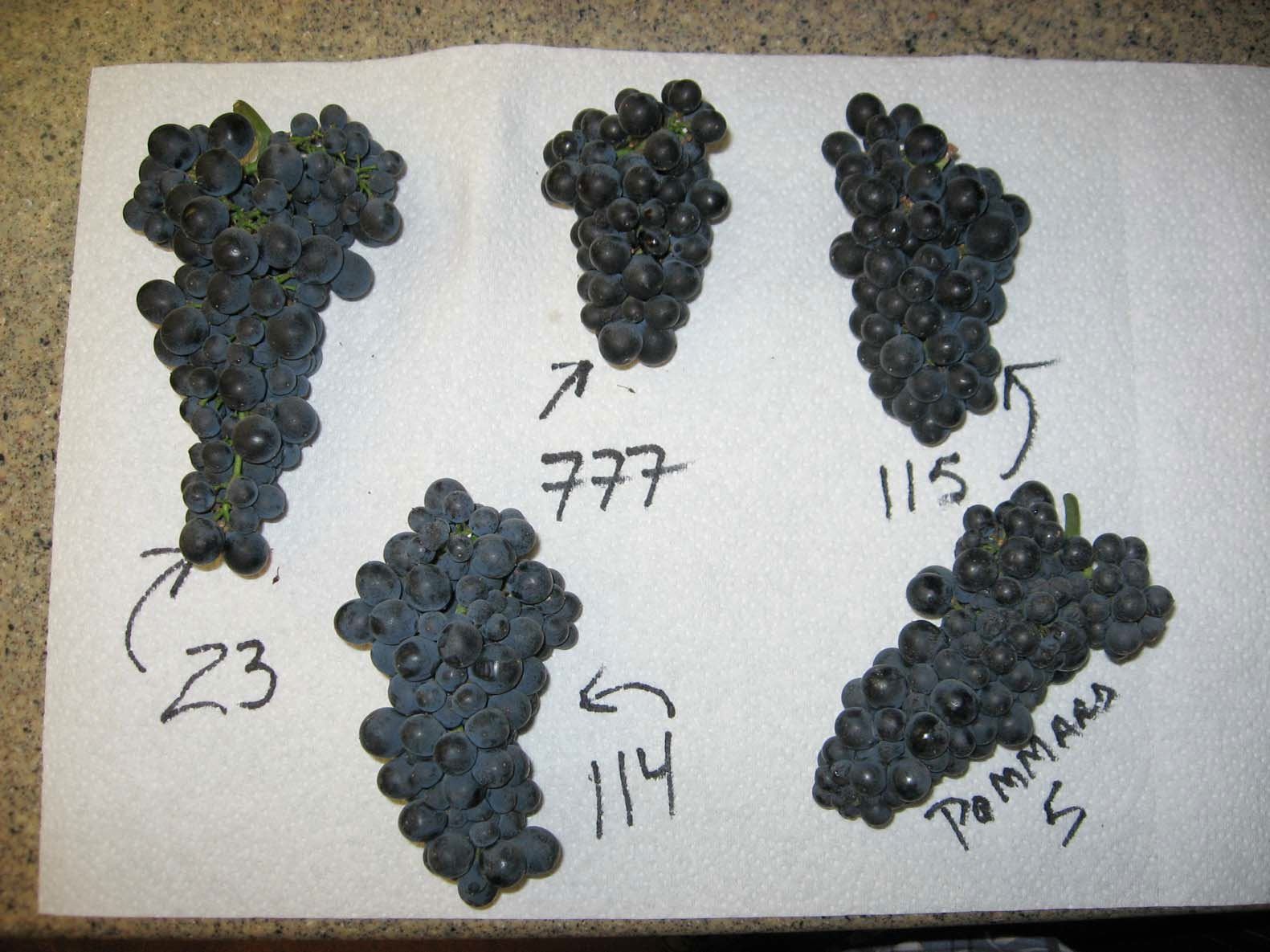
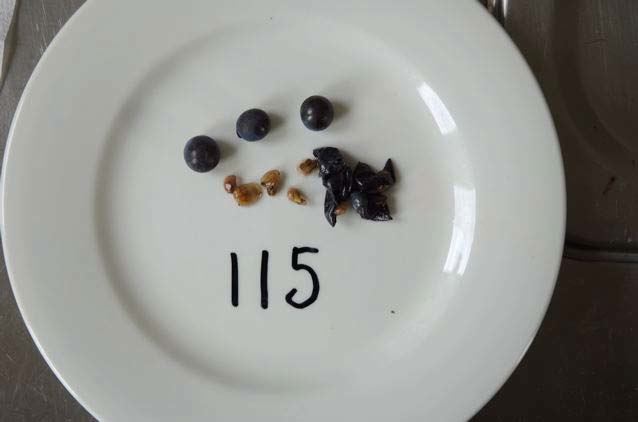
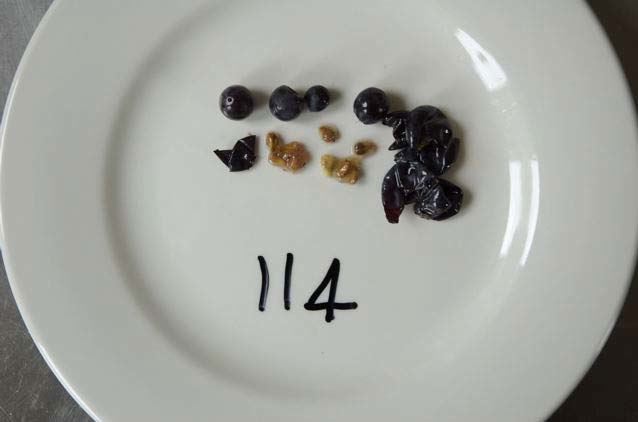
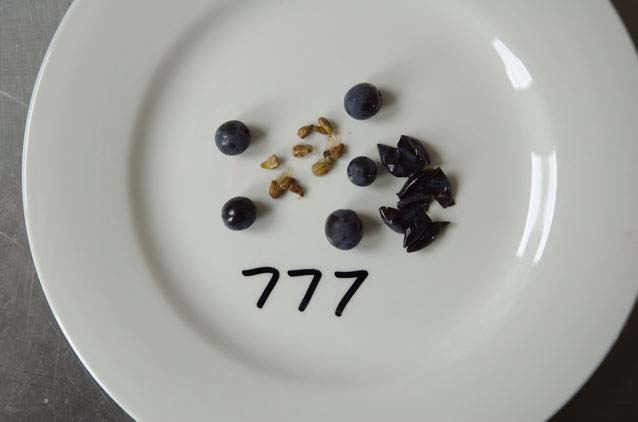
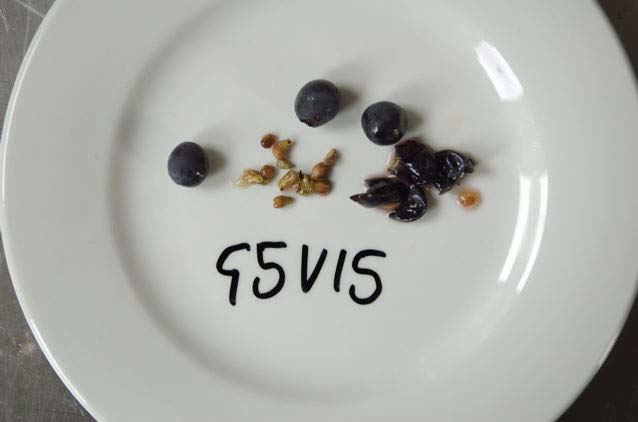
Clone 113 1971. Small to average cluster, small berries, strong color, most elegant of the Dijon clones, high
and uneven yields, variable quality.
Clone 114 1971. Small and compact cluster, small berries, very dark color, purple hue, rich aroma, good
structure, tannic, classic Pinot Noir flavors of black cherry and spice, inconsistent from site to site, can be soft,
forward and lovely or thin and hard. Shows precocious ripening with potential for higher degree of alcohol.
Clone 115 1971. Most widely planted. Smaller, tighter cluster, little hand grenades, regular yields, strong
purplish color, high anthocyanin, high pH, round, rich and supple, notable tannins, varietally consistent
aromatic profile of black cherries, leather and roses, exotic flavors of cherries, blueberries, boysenberries and
anise, age able. Can make an excellent and complete wine on its own and is valued for its balance and
aromatic profile. Consistent from different locations. Bernard told Kelly that year after year wines made at the
Lycée Viticole from clone 115 placed at or near the top of their evaluations until clone 943 came along.
Clone 375 1974. Average cluster, compact, small to average berries, quality aroma, elegant and supple, limited
age ability.
Clone 459 Very little information. Sparsely planted in North America.
Clone 667 1980. Big, tight compact cluster about the same size as 777, strong color, hi-tone and quality
aromas, dark cherry, raspberry, strawberry, spice flavors, fleshy, firm, angular, thick but soft tannin. Variable
quality depending on the site varying from green apple simplicity in warm sites where it accumulates sugar too
quickly to deep Christmas spice mix (allspice, nutmeg, clove) in cooler sites. A workhorse structural clone,
often de-stemmed.
Clone 777 1981. Small, compact cluster, small berries, low-yielding, strong and intense color due to thick
skins and higher seed count, very aromatic with dense and complex black fruit flavors (black cherry, cassis),
with leather, tobacco, and earthy notes. Can be a powerful, monster of a wine almost Cabernet-like if not
carefully farmed. Highly structured with tannin structure to age. Tannins are exaggerated in warm locations
where sugar accumulates quickly, even more so than clone 667. More consistent than clone 667 and similar in
character to clone 115.
Clone 828 Little planted in North America, so information is mainly
anecdotal. 828 was never certified for release in the United States because of issues with Redglobe virus. According to John Winthrop Haeger (North American Pinot Noir), Gary Andrus at Archery Summit imported cuttings from La Tache that were designated ASW2 and between 1997 and 2001, other wineries and growers in Oregon and California took cuttings of these vines and some was redistributed by nurseries. The selection became known as Dijon 828, but as Haeger notes, "Is almost certainly not." 828 remains in quarantine at University of California at Davis and has not officially been released by ENTAV in North America. Archery Summit has extensive plantings of ASW2 in their Renegrade Ridge, Red Hills and Looney vineyards which Haeger states, "Gives intensely flavored fruit with good color especially in marginal growing conditions." Small
bunches and small to medium berries, dense color, low pH, high sugar production with earlier maturity than
some clones. Possesses a fruit-forward character of blackberry and plum.
Clone 943 Very small berries (among the smallest of all the Dijon clones), low seed counts, small clusters
(smaller than clones 115 and 777), more open bunches, low yields, higher sugar content, intense flavors of red
berry fruit. John Kelly reported that when he visited Bernard, he told him 943 was his favorite clone and that
wines from clone 943 came out at the top of the tastings at the Lycée Viticole every year. One of the few Dijon
clones where the French negotiated a royalty payment for every bud sold in the U.S. Kelly’s reaction after
making wine from clone 943 in two vintages was enthusiastic. “The wines are dark, but elegant, and softer
than wines from the other clones, perhaps due to the lower seed count. The aromas are amazing, ethereal
unlike any of the other wines, and when I stick my nose in the wines, the pleasure centers in my brain light up
with “PINOT,” yes, in all caps. That said, I would not make a stand-alone wine from clone 943 because the
resultant wines would be too soft for my palate.”
Kelly is a firm believer in using blends of Dijon clones in Pinot Noir. “From an optimistic (winemaker’s)
viewpoint, the elements that each of the Dijon clones can bring to a blend will make a wine that is greater than
the sum of its parts. From a more pessimistic (grower’s) perspective, working with a mix of clones is a hedge
against any one of them failing in a particular vintage. Any way you shake it, clonal blends are a win-win.”
The subject of Dijon Pinot Noir clones, or are any general discussion of clones for that matter, is amazingly
complex. For those who wish to investigate the subject in more detail, I would suggest the following excellent
references: North American Pinot Noir, John Winthrop Haeger; Clones of Classic Varieties: The Pinot Noir
Portfolio, Nick Hoskins and Geoff Thorpe, www.riversun.co.nz (includes ENTAV-INRA® photos of clones);
Catalogue of Grapevine’s Varieties and Clones Cultivated in France, available in English, www.oeno.tm.fr/librairie/Collection/Viticulture/Clones/ClonesSomm.en.html







